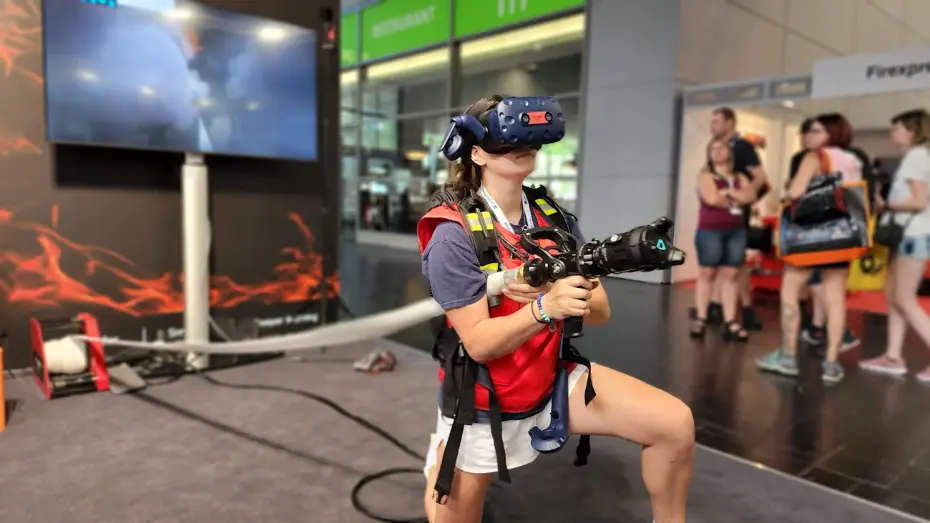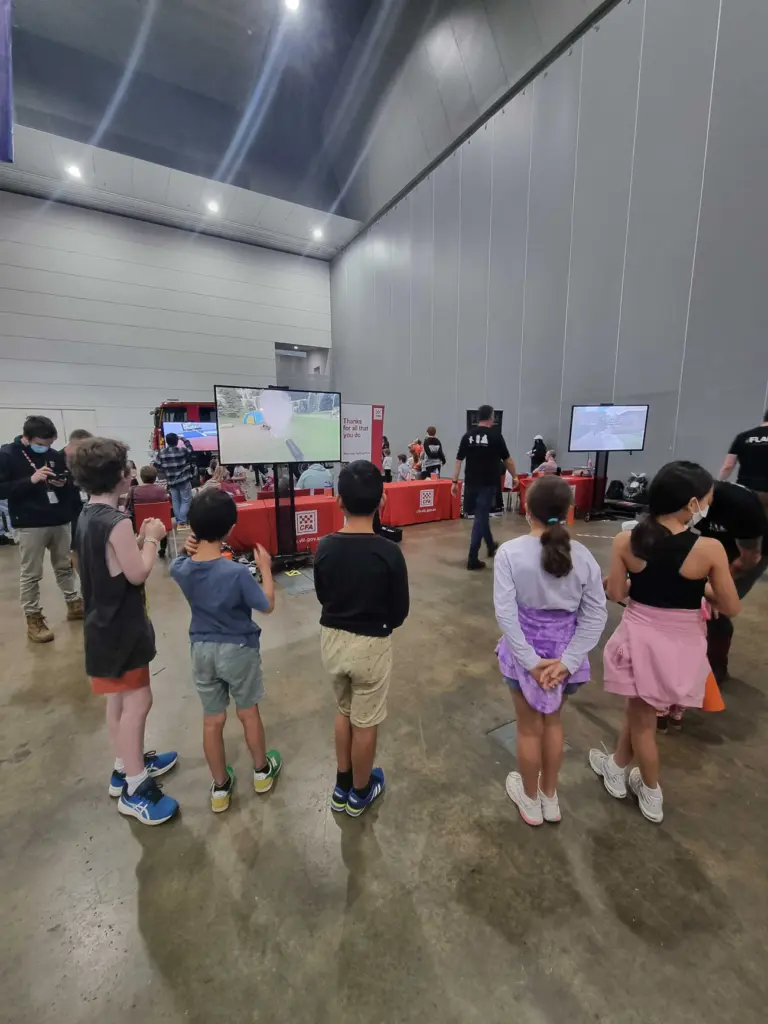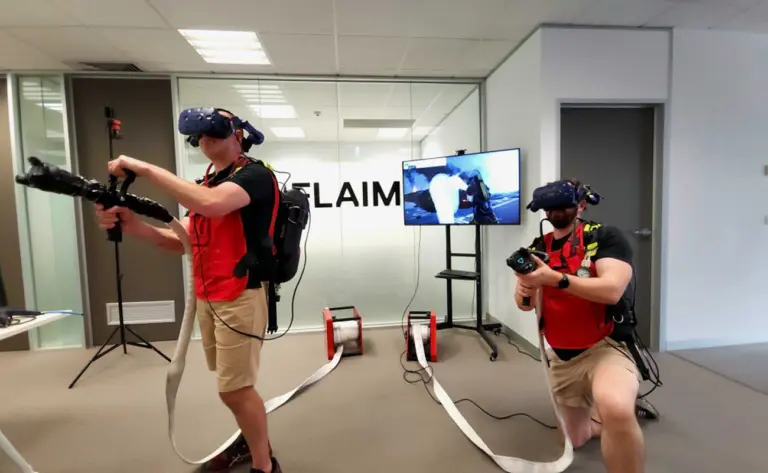This article was written by Dr Jeff Godfredson AFSM for the Asia Pacific Fire Magazine and was published on March 15, 2023. It can be viewed here.

Immersive learning technologies are much more than a training tool. The feels-real experience can help you recruit and train the next generation of firefighters, evaluate return-to-work readiness and gain community support – a multi-layered solution for the whole organisation and beyond.
A few years ago, I participated in a fire show in Australia where we were demonstrating FLAIM’s immersive learning firefighter training solution (FLAIM Trainer) to showcase its many uses. A young woman who was using the fire show as a shortcut to get a coffee asked if she could try. She kicked off her shoes, embraced the technology and was on the floor using the nozzle like a pro.
She removed the breathing apparatus, shook the sweat from her brow and looked back at the crowd and said: ‘Wow, even I could be a firefighter.’
It was then I really believed that immersive technologies were going to be a game changer for recruitment in the fire service – and would be key to helping us attract future (diverse) generations of firefighters.
Immersive learning is a global hot topic. The North American Fire Training Directors (NAFTD) and the NFPA Research Foundation have conducted a two-year study, funded by the US Fire Administration (USFA) to the tune of quarter of a million dollars, to evaluate the application of immersive learning in firefighter training as a tool to reduce risk during training and enhance firefighter safety. The initial results of the study are overwhelmingly positive.
The majority of users who purchase a system like FLAIM Trainer buy it with a specific use in mind. In reality, the system is capable of so much more. It helps them to solve or reduce a wide range of intractable problems within the fire service – a ‘Swiss Army Knife’ for the fire service.
That’s why when you are creating a business case for introducing new technologies like this, it’s important to acknowledge the various use cases across a whole organisation – beginning with community engagement and then more specific applications within a fire service.
Community engagement
The broader community: Putting a community member in the hot seat as a firefighter gives them an insight into just how tough the job is. With FLAIM, users are immersed in a variety of incident types, experiencing the physical and mental toughness of the environment. It’s an important lesson for the community. When people try FLAIM Trainer at places like public events, trade shows or shopping centres, the response is usually ‘I never knew how difficult the role of a firefighter has become’ or ‘I now have more respect for the services that the fire service provide to the community’.
It’s a great tool to engage the community and build up support and rapport between the public and your fire service.

Recruitment drives: Volunteer services globally, and in some cases, career departments, are finding a shortage of people wishing to become firefighters. With aging demographics, existing members have difficulty engaging with youth. The same can be said for organisations focused on driving DEI – Diversity, Equity and Inclusion in their service – especially those looking to increase participation of women and minority groups. Adopting immersive learning technology helps services to reach more community members, enabling them to experience firefighting and igniting a passion to consider firefighting as a career or volunteer path. You can’t be what you can’t see.
Public engagement for at risk communities: Virtual environments are a great way to educate people living in areas with potential risks such as wildland-urban interface and experience what it would be like to be inside an out-of-control wildfire. Immersive learning helps people to make more informed decisions about risk reduction and when to evacuate. A number of people who have had this experience have indicated they are no longer going to stay and defend their property and instead are now going to evacuate early on high-risk days.
Politicians and senior bureaucrats: To enable government officials, who have ultimate control over fire department budgets, to see and feel the challenges firefighters face first-hand is extremely helpful. The feedback from such exposures has been very positive – and I believe results in a higher level of support. Politicians who have experienced the system and understood the power of the kit as a tool for the fire service have then gone on to approve the purchase of such systems.
Fire Service
Recruit selection and training: FLAIM Trainer can be used as a recruitment tool to help you get the right people. It gives you an insight into how they will respond to a number of performance requirements such as their ability to handle jet reaction, claustrophobia and how they will react in a pressured environment. Memphis Fire Department is the first metro fire service in the US to begin to engage recruits with FLAIM Trainer. Fire Chief Gina Sweat, herself the first female Fire Director of Memphis, wants to be the best, most innovative fire department in the country.
Ongoing skills maintenance: Throughout their time in the fire service, a person will suffer from skills fade if they do not continue to practice their basic skills. Immersive learning technologies enable firefighters the opportunity to practice firefighting and dynamic risk assessment throughout their career. For volunteers, they get the same benefits at a time and place convenient to them. The same goes for risk assessment, incident command and working together making split-second decisions in high-pressure situations. We learn more from our failures than our successes – and the key is being able to replicate high-risk, low-frequency incidents – and fail in a controlled safe environment which is not repeatable with live fire

Return to work: During their service, some firefighters will have injuries, both mental and physical, that may require them to take time off duty. The FLAIM Trainer can be used as a tool for rehabilitation, rebuild confidence and to evaluate and assess work readiness. Training can be done in private with appropriate support people present.
Post-traumatic stress disorder (PTSD): All firefighters are going to be exposed to traumatic scenes as part of their service. I remember when I first joined the fire service, as part of the recruitment process, we were shown traumatic images of accident and fire victims. This certainly did not equip us to deal with the real thing. With FLAIM Trainer you can experience repeated exposure to trauma in a controlled way under the supervision of professionals that can reduce the impact of future events – a form of immunisation. For those who have been exposed to trauma and have found it difficult, the system offers a tool to safely expose people to stressful environment with a dedicated professional by their side (this is similar to work being done with the war Veteran community). It could also be used by members of the public potentially affected by disasters, pre and post the event in their communities, such as bushfires and floods.
Training record: Firefighting is dangerous, and all organisations need to equip their people with the skills and equipment required to keep them safe on the fireground. Because managers have a duty of care for their team members, it’s important all fire services have a defensible record of all training. The digital data capture available in immersive learning systems provides a detailed, unbiased record of training activities that can be linked to a learning management system. This provides significant safeguards for both the organisation and the individual. Such systems can also provide ongoing prompts to both the firefighters and management regarding training needs and requirements for recertification. Such risk management is an obligation for senior officers in the fire service.
How FLAIM Trainer has evolved to meet demand
When the idea for FLAIM’s haptic hose reel was first conceptualised by a young robotics engineer and veteran volunteer firefighter in country Australia, the team never imagined its far-reaching impact. Now in seven continents (yes, they even have the need for fire training in Antarctica!), feedback from users all over the world is helping to shape the future of the immersive learning solution. FLAIM Trainer is now at the centre of many organisations’ recruit drives and training, and sailors can now train for high-risk, low-frequency incidents such as a helicopter crash on a frigate.
Immersive learning and its various applications are truly a ‘Swiss Army Knife’ for the fire service.